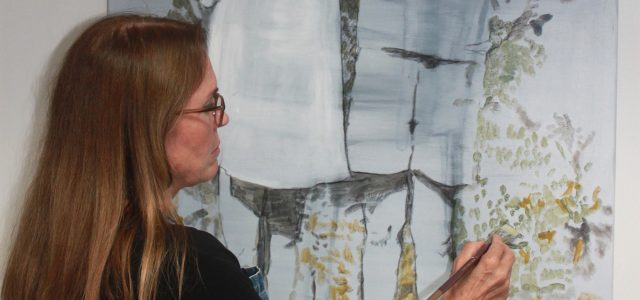
ALL CHANGE
A hugely prestigious art conference and exhibition held in Spain is featuring work by talented artist and lecturer Cerise Ward
Living on the fringe of the Ribble Valley, artist Cerise Ward is currently showing her work at a prestigious international exhibition and conference in Santander, Spain.
Cerise was selected for the Impact 10 conference as a specialist in her field, after submitting her application in January.
Established in 1999 Impact, standing for International Multi-disciplinary Printmaking Artists, has been held at venues throughout the world including China, Estonia, Berlin, Cape Town and Australia.
Having already been chosen to exhibit her work at Impact 7 in Melbourne, Cerise was thrilled to be chosen again this year: “I was over the moon when I was selected,” she says. “I didn’t hear for ages, but I later learnt that was because there had been so many entries this year. Having been selected for a second time is wonderful!”
As one of the artists at Impact 10, Cerise will represent her work, which will be installed at the Museum of Prehistory and Anthropology of Cantabria.
“I was thrilled when I learnt where my work was to be exhibited, as it is so relevant” says Cerise, who focuses her art on social history, family diaries and photographs, the impact of war on the home front and the fluidity of life.
Her submission for Impact 10 is the Book of Trace, which through art, investigates the construction of family history.
Having always been fascinated by the past, in particular how each generation documents and archives their own personal history, Cerise’s intrigue was originally sparked when she was given a diary by a relative a number of years ago.
The diary which belonged to her great, great aunt Jane, born in the late 1800s, was a visual recording of life at that time including cuttings and drawings. It was while studying for her Masters at Monash University in Australia, that Cerise based her thesis on the diaries creating a series of large-scale ‘pixelated’ drawings in graphite, based on the cuttings portraying various events and tragedies.
Returning to the UK in 2012 Cerise continued to use diaries and family archives to construct her artists books, which are books conceived by artists and rendered in a specific medium. The two books, My Little Book and My Book of Tales, Cerise exhibited at Impact 7 feature in the highly acclaimed book The Silent Scream: Political and Social Comment in Books by Artists compiled by Peter Lyssiotis and Monica Oppen, who has one of the largest collections of artists’ books. Cerise’s work is exhibited alongside books by world famous artists such as George Grosz, Oskar Kokoshka, Max Beckmann and Gerhard Richter.
“Artists’ books can take any form,” explains Cerise, whose Impact 10 collection of drawings is imprinted on an old wallpaper sampler book, based on historical English designs, many of which feature a ‘discontinued’ cross on the surface.
“When I came across the book I realised it was just perfect as it represents the home and the discontinued markings emphasise the fact that things do come to an end.”
The Book of Trace has already featured in an exhibition at the Museum of Lancashire before Cerise took it to Spain to install it at the Impact 10 conference. The inspiration for the book again came from family history and culture, but Cerise was also inspired by a poetry book by Alfred Lord Tennyson, given to her by a late friend.
Within the book Cerise noted two poems All Things Will Die and Nothing Will Die: “It is about opposing views of life and how we are lured into thinking that nothing changes, but it actually does. We are not aware of our own mortality,” adds Cerise, whose book combines her drawings with quotes from the poems, which she has hand drawn in a font she personally designed.
“Combining text with images can be the most difficult thing to do,” explains Cerise, who creates her images by scanning old photographs and projecting them to enlarge them, revealing individual pixels, which she has drawn in graphite on the faded wallpaper.
“The pixilation of the images indicates a degree of disintegration, which again fits in with the theme of change.”
Included in the book is an image of a football team from WWII and a pigeon – a reminder of Cher Ami, the homing pigeon donated by pigeon fanciers during WWI that was famous for delivering a message to an encircled battalion, which saved the lives of 200 American soldiers.
“When I was in Australia a wood pigeon used to sit on the chimney and coo, and when we returned to the UK the same thing happened in our new house!”
“When we moved to Blacko it happened again,” recalls Cerise, who is a lecturer at Nelson and Colne College. “There is this consistency that is a continuity of life and it is this that lulls us into a false sense of security that nothing will change.”
“But we are all heading along the same conveyor belt that never stops. Children are evidence of change as we see them grow up.”
Cerise Ward’s work has been shown at The Mall Gallery in London and acquired in high profile collections at Southern Cross University in New South Wales, Australia, the Library for the Artists’ Books in Sydney and the State Library of Victoria in Melbourne.

